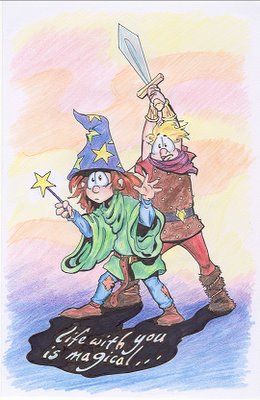Last Thursday, as you all know, was my wife and my ninth wedding anniversary. Before I went to work my wife recommended that I wear a suit and tie to work so that I would be ready for our dinner. In years past I have planned the anniversary dinner, but this year Jody "demanded" the privilege. She then asked me if I was "excited" about our dinner. I responded calmly that I was very much looking forward to a romantic evening with my wife.
She scowled and said, "but are you
excited about
where we are going?"
I told her that I didn't know where we were going and I once again assured her that I was looking forward to a very romantic evening.
Once more the scowl.
So I asked, "okay...where
are we going?"
"It's a surprise," she giggled, then she hugged me and skipped off to her car. All of which left me wondering what she had planned. Too be honest, I didn't put much thought into it for most of the day. It wasn't until I was on the road from Glendora to the Paramount Lot (the Marx Building for JC and Wolf) that I began to really attempt to guess at the surprise.
Jody called my cell while I was on the road, "any guesses?"
"Do you really want me to guess or do you want me to be joyously surprised when I get to your office?"
"I want you to be joyously surprised."
"Then I'll wait until I get to your office and react to the news." I can hear the grimmace on the other end of the cell.
All of this has finally caused me to really think about where Jody has planned for us to go to dinner. What could be this important? Think, think, think. We went to
Spago for Jody's birthday and it was great, but even that wasn't as big a deal as Jody was making this evening. Hmm...other than Disneyland, for which one evening wouldn't be enough, what place would be special enough to make Jody giggle?
I finally decided that it must be the
Magic Castle. I am a big fan of magic and have always wanted to go there. Jody received an invitation from a member over a year ago and we have been unable to use it. It was featured in a Columbo episode (Jody's favorite show ever). I hoped I was right and tried to brace myself for any disappointment.
I arrive at her boss's office and Jody is busy in the phones, but she has time to hand me a hand made anniversary card. She smiles broadly and says, "open it!"
This is what I see.

Well, this and the invitation to the Magic Castle. I had been right and I laugh out loud, "Awesome," I am Gen X after all, "I hoped this is where we were going to go."
"Good thing we are then," she laughed.
Jody's playfulness was fun, but the Magic Castle was better than I expected. We ate dinner at their steakhouse. It's no Spago, but eating there meant we didn't have to pay for the "Palace of Mystery" show.
When you go to the Magic Castle,
which requires an invitation and reservations, there are basically four venues where performers baffle and amaze you. At least they try to baffle and amaze you.
There is the Close Up Gallery where magicians give performances every 45 minutes or so for the duration of the evening. This is where you will see card tricks, sponge ball manipulations, and coin tricks. You know what I am talking about, all the slight of hand trick you can imagine might be performed here.
There is the Parlour of Prestidigitation where everything inbetween close up and stage performance is done. In the Parlour you will experience Mentalism and the types of tricks you might imagine experiencing in a Victorian living room.
Then there is the Palace of Mystery where stage magic is performed. This can be everything from "large" slight of hand tricks and animal tricks to large mechanical tricks like the famous sawing the woman in half trick.
Finally, there is the W.C. Fields bar where the bartender does a continuous demonstration of barside magic. As you can probably guess the majority is close up magic, but humor is a big part of this experience as is drinking.
We had a great time. We watched two perfomers in the Close Up Gallery (Paul Green and David Stryker) one "early" performer and one "late" performer. At the Palace of Mystery show we saw
Shoot Ogawa and
George Saterial. We even hung out at the W.C. Fields bar for a while. Sadly, we weren't able to catch one of the shows at the Parlour, it was a Thursday and there was no midnight performance in the Parlour.
All the magic was excellent, but the magician who most impressed me was David Stryker. He performed a couple of "classic" manipulations, but with awesome fluidity. He was worth the very late stay and was not only a skilled magician, but an approachable and friendly one as well.
Oh...and before I forget. In addition to the magic, Jody and I were able to do some gawking as well.
Neal McDonough was there with friends, as was
Sam Jones III. If you are a comic book geek, you might appreciate that McDonough was the voice of Firebrand on an episode of Marvel Action Hour: Ironman and was the voice of Bruce Banner on the 90s animated series. Thought I was going to mention Smallville, didn't you.


